Paris Saint-Germain are blessed with a huge and highly fruitful catchment area of young talent from which they can essentially pick and choose the elite of the elite at youth level to place in their academy, develop and all going to plan, eventually add to their first team.
One player who’s gone through this process is 20-year-old right-footed centre-forward Arnaud Kalimuendo (175cm/5’9”, 63kg/138lbs). The attacker spent the last couple of seasons out on loan at PSG’s fellow Ligue 1 competitors Lens, ending this past season as the joint-ninth-highest goalscorer in France’s top flight, tied with Strasbourg’s seasoned striker Ludovic Ajorque for that position, having taken and scored one less penalty than the 28-year-old.
Kalimuendo has now got just two years remaining on his contract in Paris, while he’s said to have attracted interest from EPL sides Leeds United and Nottingham Forest, as well as Serie A giants Inter, among others, this summer.
This tactical analysis and scout report aims to look at why the 20-year-old Parisian is seemingly so in demand at present via analysis of his style of play, key strengths and weaknesses and role within Franck Haise’s Lens tactics that helped him to perform at such a high level this past season. We aim to point out exactly what interested clubs must know about the PSG prospect, good and bad.
Movement
One of the things to watch in any centre-forward game is their off-the-ball movement; how do they like to provide their teammates with options? What kind of runs are common for them? How good are they at finding space for themselves in threatening areas at just the right time?
Kalimuendo frequently demonstrates effective movement in the final third to free himself up and give his teammates an option in dangerous areas. This played a key part in his 3.6 touches inside the box per 90 last term, per Wyscout — a relatively high number when compared with the rest of Ligue 1’s centre-forwards.
Additionally, this helped Kalimuendo to end up taking a relatively high number of shots (2.52 per 90, according to Wyscout) when compared with the rest of Ligue 1’s centre-forwards for 2021/22; effective movement to generate space in high-value positions isn’t the only thing that helped Kalimuendo in this regard, but it was certainly a key factor.
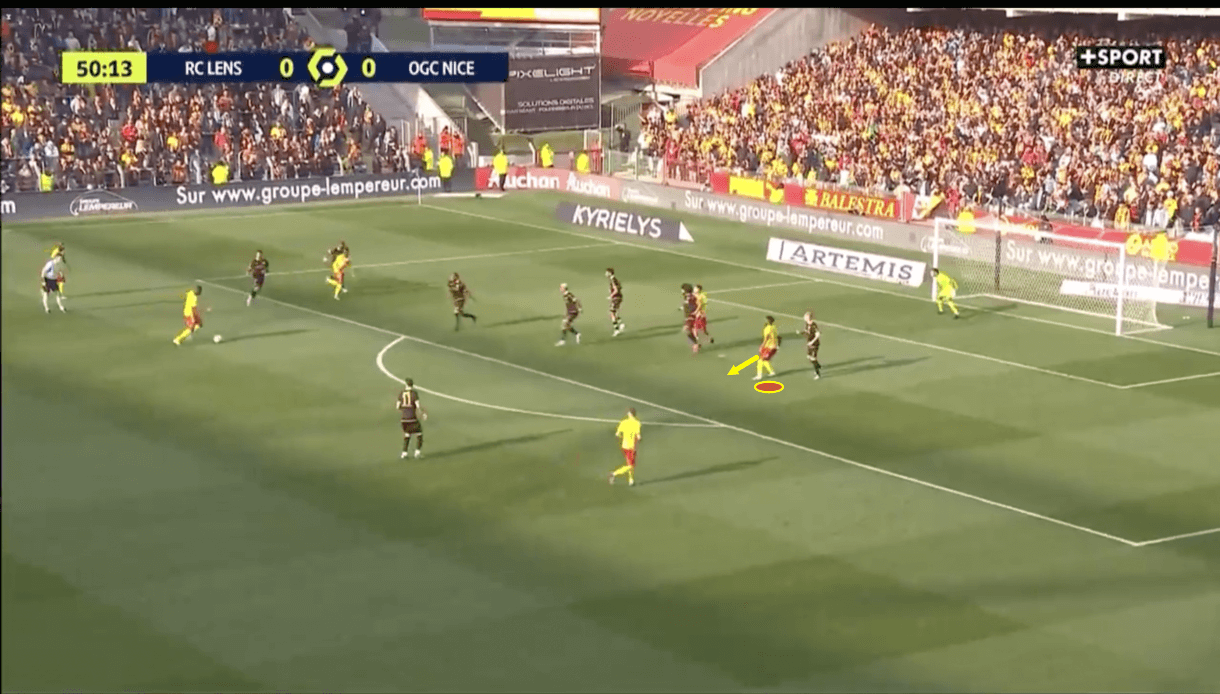
Before Figure 1, we saw Lens working the ball into a good crossing position on the left wing while Kalimuendo shifted around inside the box to ensure he stayed in space, away from the defenders around him. Additionally, just before this image, the striker took a couple of extra steps back to give himself space to run forward once the ball is played, anticipating the danger of this particular chance his side was building and the impending through ball on the wing in behind the opposition’s backline.
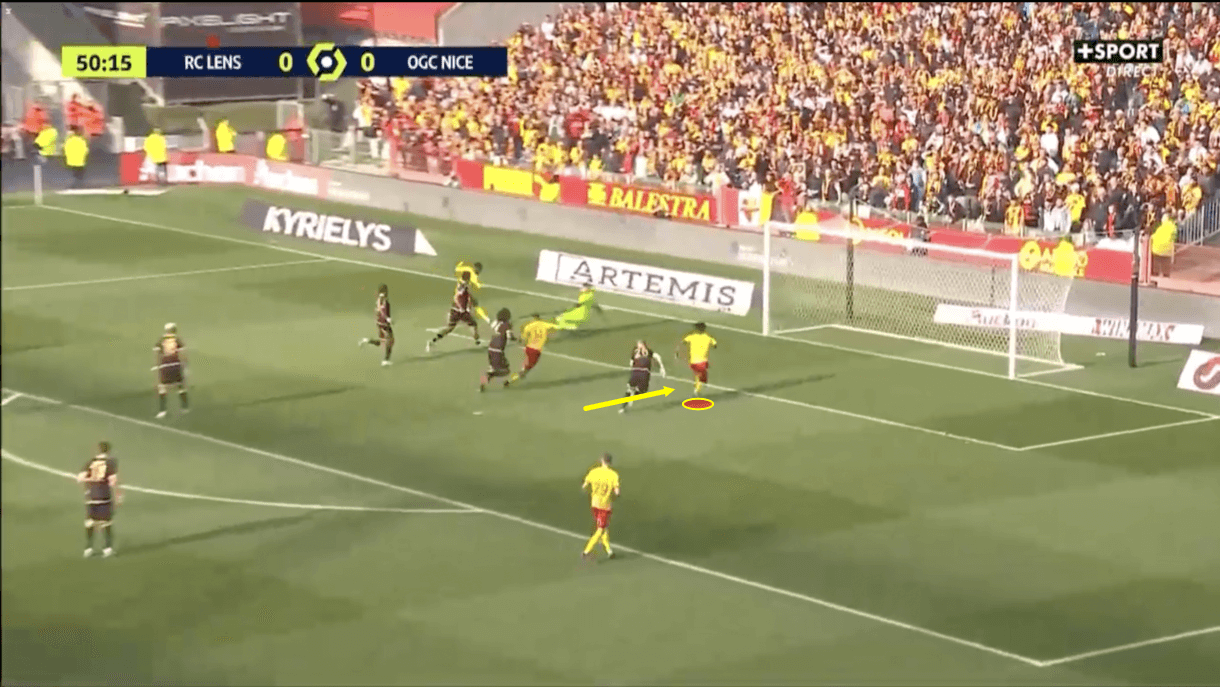
As the ball went in behind the opposition’s backline and towards the byline where Lens’ wide man on the left chased it down, Kalimuendo burst into action and thanks to the additional step backwards before the pass was played, was able to generate some speed and get well ahead of the defenders, putting himself into a very good goalscoring position as his teammate entered his crossing position in figure 2.
However, the pass didn’t come straight to Kalimuendo’s feet here, as the congestion around the ball carrier led to the ball being deflected slightly behind the 20-year-old’s running path, rather than the ideal situation of the ball being driven in front of him to run onto.
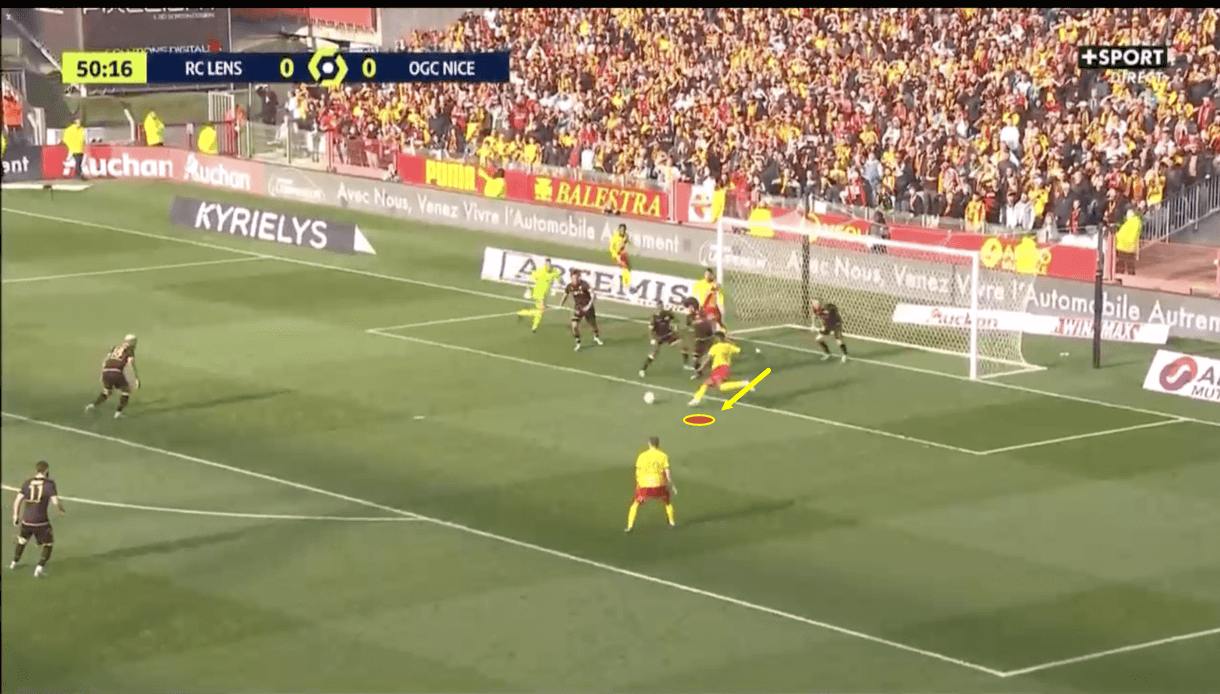
As we progress into figure 3, though, Kalimuendo ended up being the first to react to this deflection and got a shot off despite the cross not going perfectly. This passage of play provides an example of a few noteworthy elements of Kalimuendo’s game. Firstly, he’s good at retaining distance and separation from opposition defenders in high-value areas.
Additionally, Kalimuendo tends to pull off subtle movements in those high-value positions, such as the backwards steps prior to the ball being played in figure 1, which gives him an increased advantage in those areas once the ball is played. These little movements can make a big difference to the end result as was the case when we progressed into figure 2 and saw how the striker was able to generate so much pace and dart in front of the other defenders into a valuable position.
Lastly, Kalimuendo has great reactions and can change direction off the ball quite quickly, both of which were important qualities that contributed to him ending up on the ball in a goalscoring position in figure 3. So, even if everything out of his control doesn’t go perfectly despite having great off-the-ball movement, Kalimuendo can recover and make the best of the situation as we saw in this passage of play, which is a highly valuable trait for his team that can lead to extra shots in these high-value positions than someone without this skill would create.
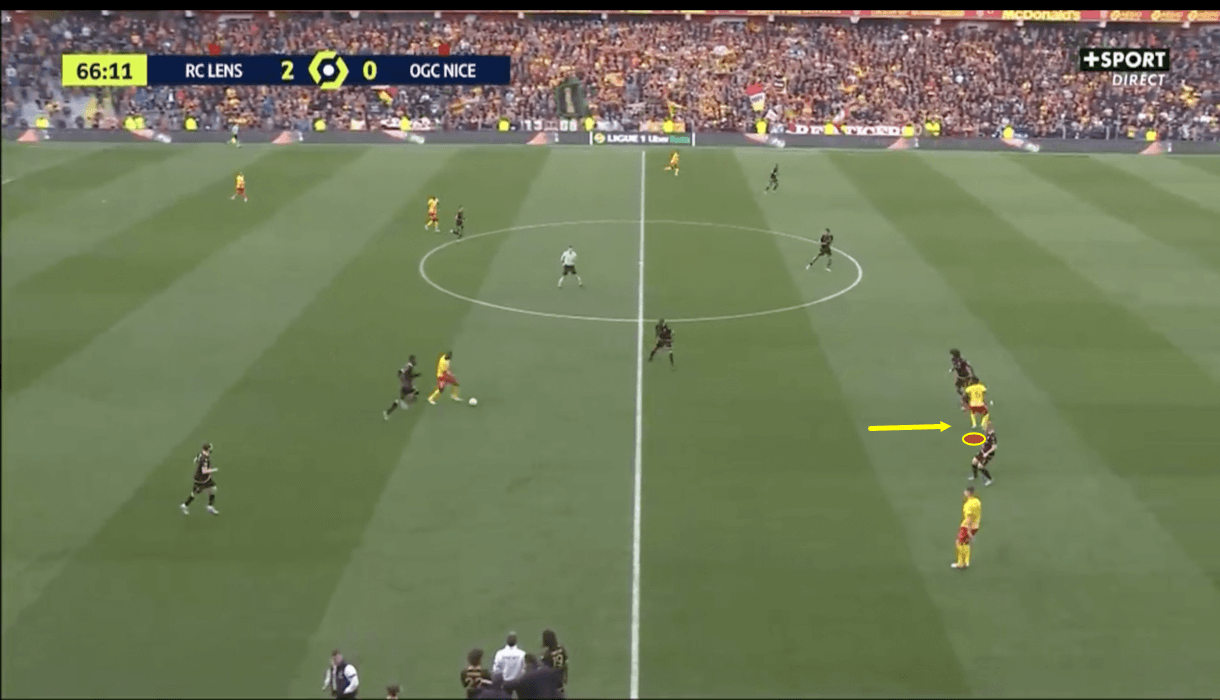
Kalimuendo has great acceleration and an impressive top speed, making him a significant threat when playing against a higher line as well. However, pace alone isn’t enough to make him a threat in this area, he also needs to time his runs well, which he’s generally demonstrated a good ability to do. Figures 4-6 will highlight this area of the PSG attacker’s game.
Starting with figure 4, just before this image, Kalimuendo made a dart forward, aiming to provide the deeper ball carrier with a through ball option in behind the opposition’s high line. The striker spotted a good opportunity to break into space behind Nice’s backline and give his teammate a very nice option but the pass didn’t come, with the ball carrier ultimately holding onto the ball.
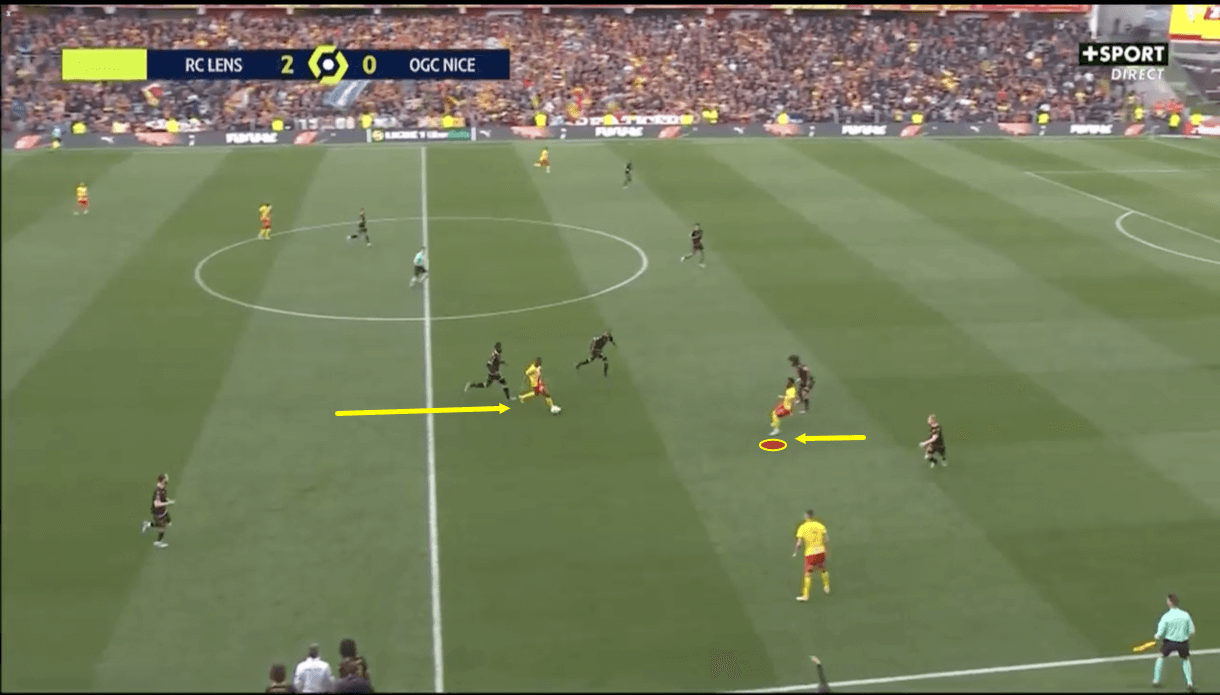
After the pass didn’t come, the ball carrier continued moving forward on his own while Kalimuendo dropped — probably not to try and give the ball carrier an option to feet, as the space is still behind the opposition’s backline, but rather to remain onside, readjust his own positioning and prepare for another run in behind the backline. This was some quick thinking and an intelligent adjustment from Kalimuendo that helped to keep the possibility of exploiting the opposition’s high line alive.
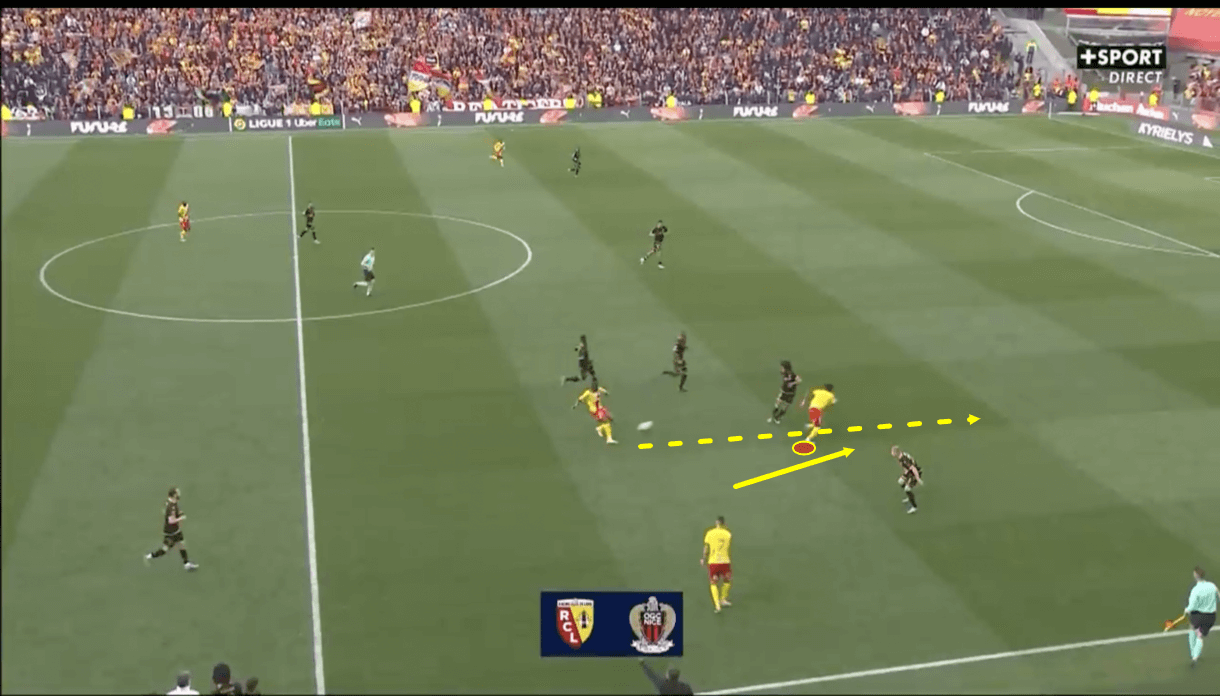
A couple of seconds later, Kalimuendo has gone again, turning from the position we saw his body in figure 5 to the forward, goal-facing position we see in figure 6. Now, the pass is played and the 20-year-old can sprint beyond the backline uninhibited without having to worry about holding up his run to remain onside. This leads to Kalimuendo progressing into a 1v1 with the opposition’s goalkeeper that he wins.
From this passage of play, we again see how Kalimuendo combines intelligent movement with the pace and power he possesses to create a good passing option — and ultimately a good goalscoring opportunity — for his team. From there, the technical ability to beat the opposition’s keeper and take advantage of the opportunity comes to the fore.
Shooting
In terms of technical shooting ability, Kalimuendo is really exciting. His movement is good and he can generate space in high-quality areas from where to get a high-xG shot off when required, such as in the situation we observed in figures 1-3.
As mentioned in the previous section, this plays an important part in his high number of shots per 90 but it’s not the only reason/explanation for that high shot count. The France U21 international is also comfortable shooting early and from awkward positions.
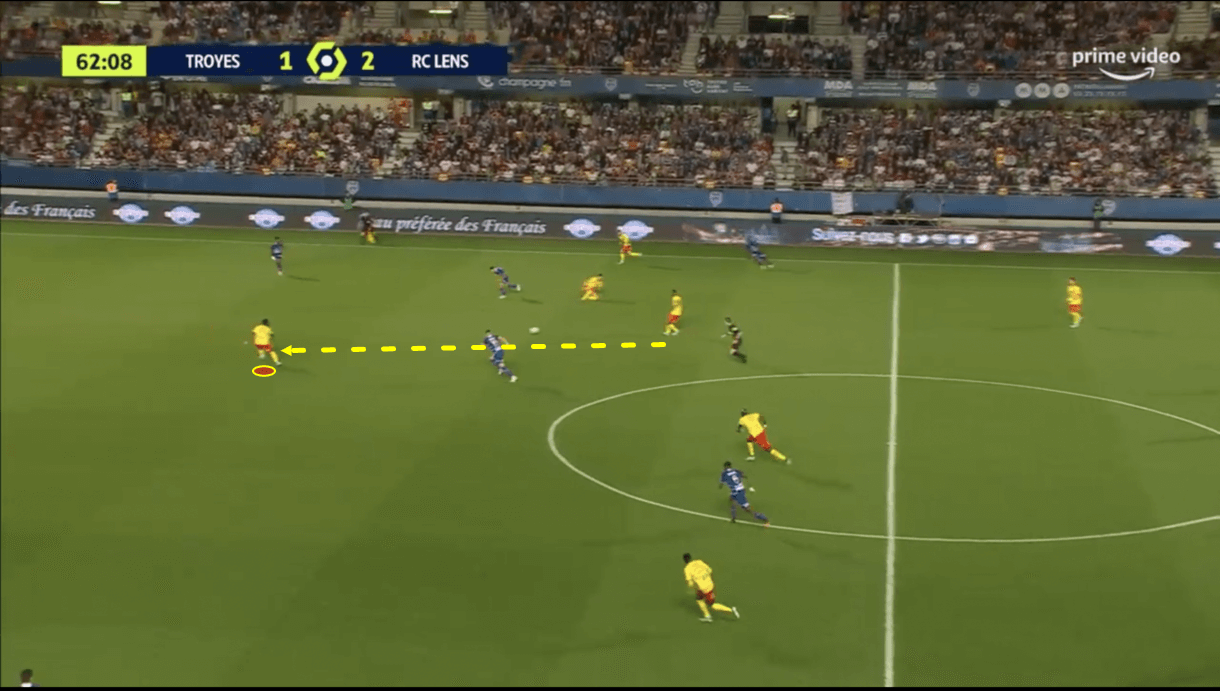
We see an example of what we mean by this in figures 7-8. Firstly, in figure 7, the attacker receives a through ball from a deeper teammate just in front of the opposition’s backline, with Troyes deploying a deeper line here than Nice were deploying in figures 4-6. This denied Kalimuendo space to just carry the ball into a 1v1 with the ‘keeper, and the PSG attacker isn’t one to constantly look for 1v1 duels with defenders to engage in — he’s got decent dribbling ability but he isn’t ‘a dribbler’ by trade, so to speak, he’s a different type of player.
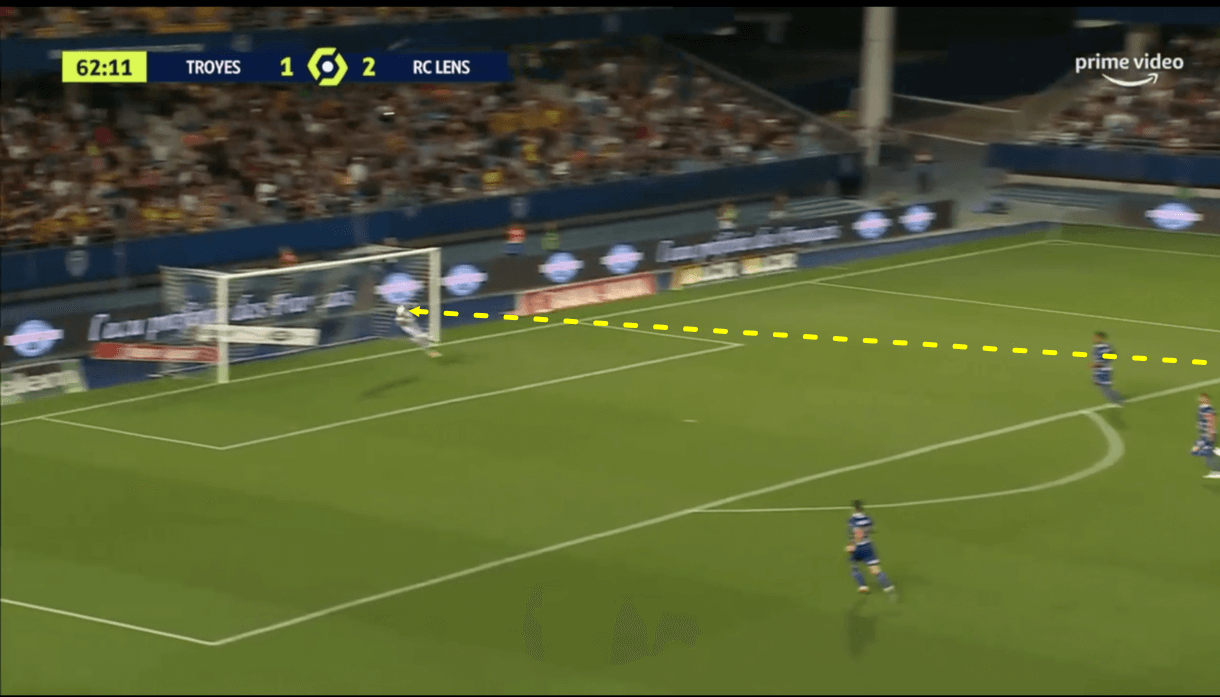
Kalimuendo is a comfortable long-distance shooter, though, which makes dropping deep and giving him space like this in front of the backline a dangerous game. After receiving the ball, turning and taking a touch here, the attacker launches a powerful long shot with his stronger right foot, forcing the opposition’s keeper into a great save that gives Lens a corner-kick to try and score from.
Indeed, Kalimuendo isn’t the example of an attacker that constantly shoots from high-value positions and maintains a nice, low average shot distance. His shot map is more scattered than some would perhaps even like. However, one of the most impressive things about this attacker’s game is his ability to shoot with great power while maintaining accuracy; this holds true when looking at Kalimuendo’s long-range shots too.
The attacker frequently shoots from long-range or from awkward angles, yet he ended the 2021/22 Ligue 1 campaign with a very solid 52.38% shot accuracy rate, per Wyscout, while FBRef ranks him in the 93rd percentile for shots on target percentage when compared with strikers from Europe’s top-five leagues for the last calendar year.
So, while Kalimuendo does only shoot from high-value positions and takes on low-xG chances regularly, he’s got the ability to back up such decisions and while they may not always result in goals, as was the case in figures 7-8 with the ball being parried away for a corner, it does create an opportunity for Lens to take advantage of the resulting set-piece as his accurate shots can be too hard to hold onto.
Furthermore, as teams become more and more aware of Kalimuendo’s long-range threat, they may start to deny him this space between the lines, which could then lead to space opening up behind the backline again, which Kalimuendo or perhaps one of his teammates can then exploit.
One negative about his shooting game is that he sometimes snatches at opportunities and drives them either high or wide — if not both. This can leave you frustrated as a viewer who sees the wasted opportunity but allowing Kalimuendo the freedom to shoot without strict regulations may be beneficial in the long run as he knows what he’s capable of pulling off and what he’s not capable of pulling off and generally seems to have decent judgement which should improve as necessary over time through iteration. I wouldn’t say there’s much of an issue in terms of shot selection.
Additionally, to restate an earlier point from our first section of the analysis, Kalimuendo possesses the ability to find space in high-value areas when required so if operating in a stricter system that looked to maximise opportunities like we saw in figures 1-3 and minimise, for example, long shots, we’re confident Kalimuendo is capable of playing that role.
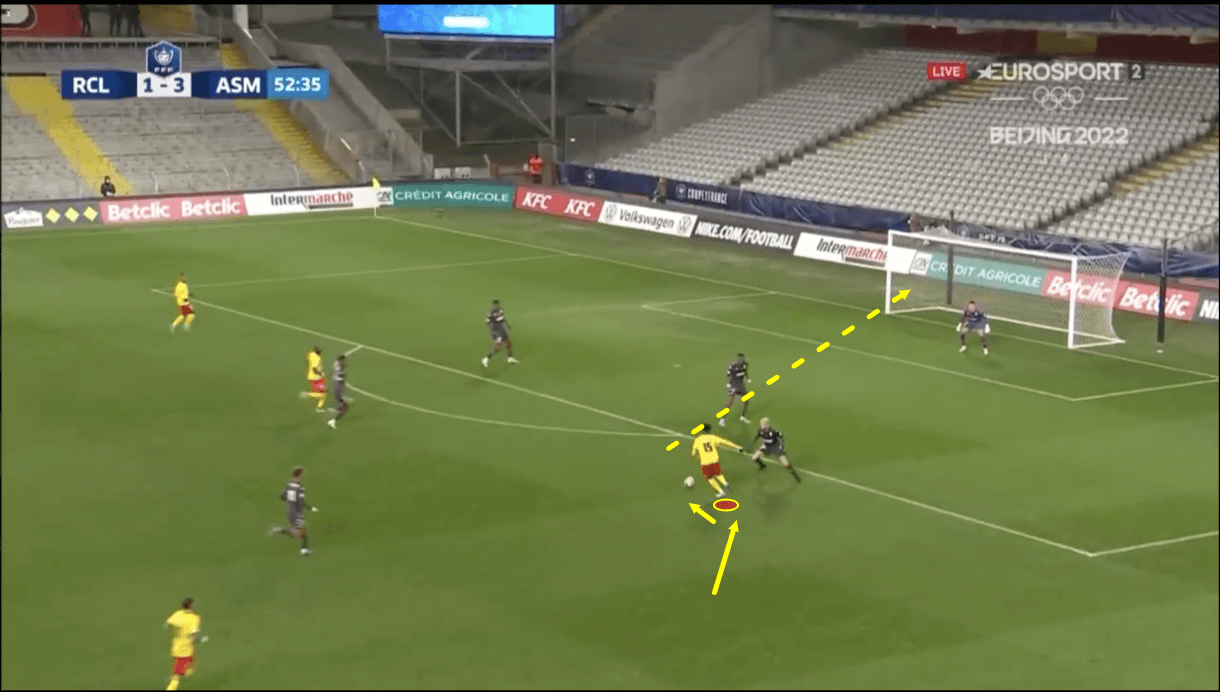
While Kalimuendo is a right-footed attacker, he’s quite two-footed and is comfortable shooting with his left foot which can make him very difficult to defend against. We see an example of this versus Monaco in figure 9. Here, the opposition defender focused on preventing a shot from Kalimuendo’s right, not necessarily showing him onto his left foot but not going out of his way to prevent the left-footed shot either, prioritising protection of the other side.
However, Kalimuendo showed the defender he’d made a mistake here as he fired a rocket off his left foot into the far corner of the net. The attacker can produce his signature high-power, high-accuracy shot off either foot, which adds a scary element to his game as a defender, as one of the bits of knowledge a defender relies on most heavily is: which foot is strong? With Kalimuendo, yes, his right foot is strongest but could you call that left a weak foot?
Two-footedness is always a highly desirable trait, especially in a centre-forward and this alone adds a lot of value to Kalimuendo.
Link-up play
Another desirable trait in a centre-forward is the ability to link up with teammates on the ball. Last week here at Total Football Analysis, we provided a scout report on another of Ligue 1’s bright young attacking prospects: Sepe Elye Wahi of Montpellier. Link-up play is an area in which the Golden Boy nominee falls short. However, that isn’t the case with Kalimuendo, who thrives in this area.
Kalimuendo possesses technical ability on the ball far in excess of that which Wahi offers. Though the 20-year-old doesn’t play a lot of passes, even for a centre-forward — perhaps as much a result of his role at Lens as anything else — his pass accuracy is excellent.
No, Kalimuendo isn’t much of a playmaker and through passes are an area where he can vastly improve, as his accuracy and ability to weigh those types of passes aren’t good. However, in terms of dropping away from the opposing defence into space in front of them and linking up with teammates, firstly by getting into a position to receive the ball and then facilitating progress to another teammate by quickly playing it off again into their feet, Kalimuendo is a good option to have.
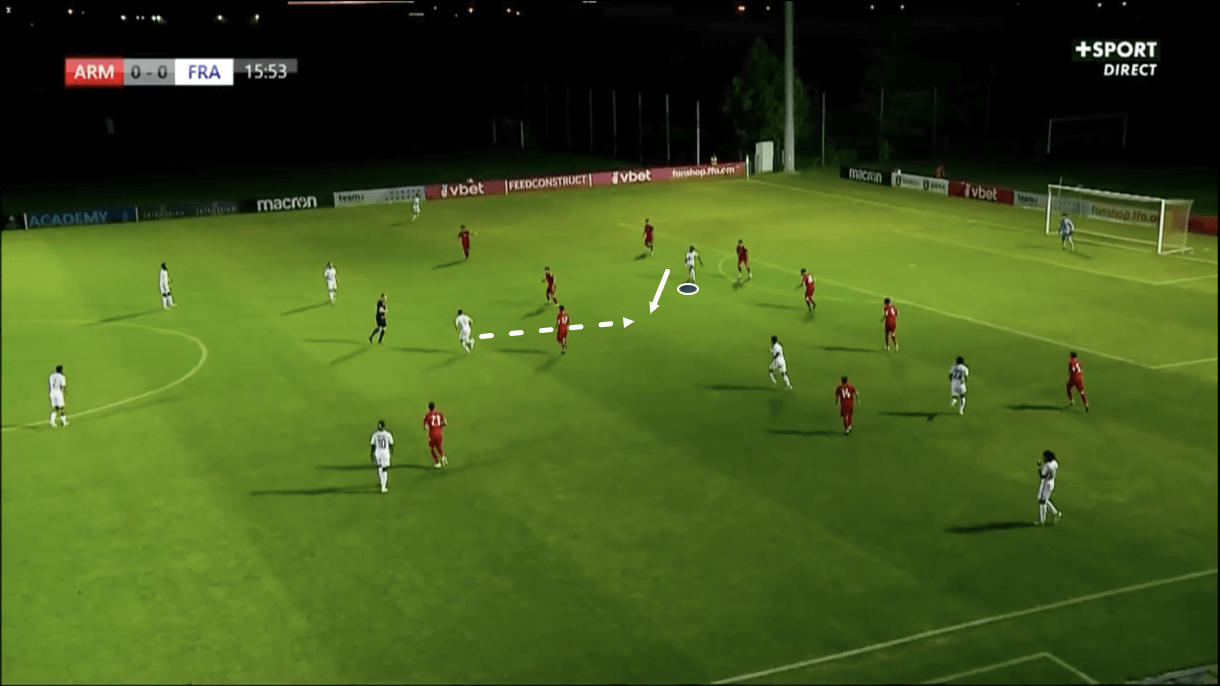
Take figures 10-11, for example. Here in figure 10, we can see Kalimuendo beginning to drop away from the backline, having spotted a hole of space in front of the backline and behind the midfield line which lines up a potential passing lane for the ball carrier. Kalimuendo demonstrated great vision by spotting this space to invade, as well as the fact that he always has one eye looking for space like this where he can move into and provide a teammate with an option.
Had Kalimuendo not moved into this space, the ball would probably have to have remained deeper, with the midfielders continuing to circulate between each other so the value of a striker like Kalimuendo in this type of situation is evident in that it facilitated progression through the opposition’s midfield line while disrupting the opposition’s backline as someone had to push up from their settled shape to deal with Kalimuendo between the lines.
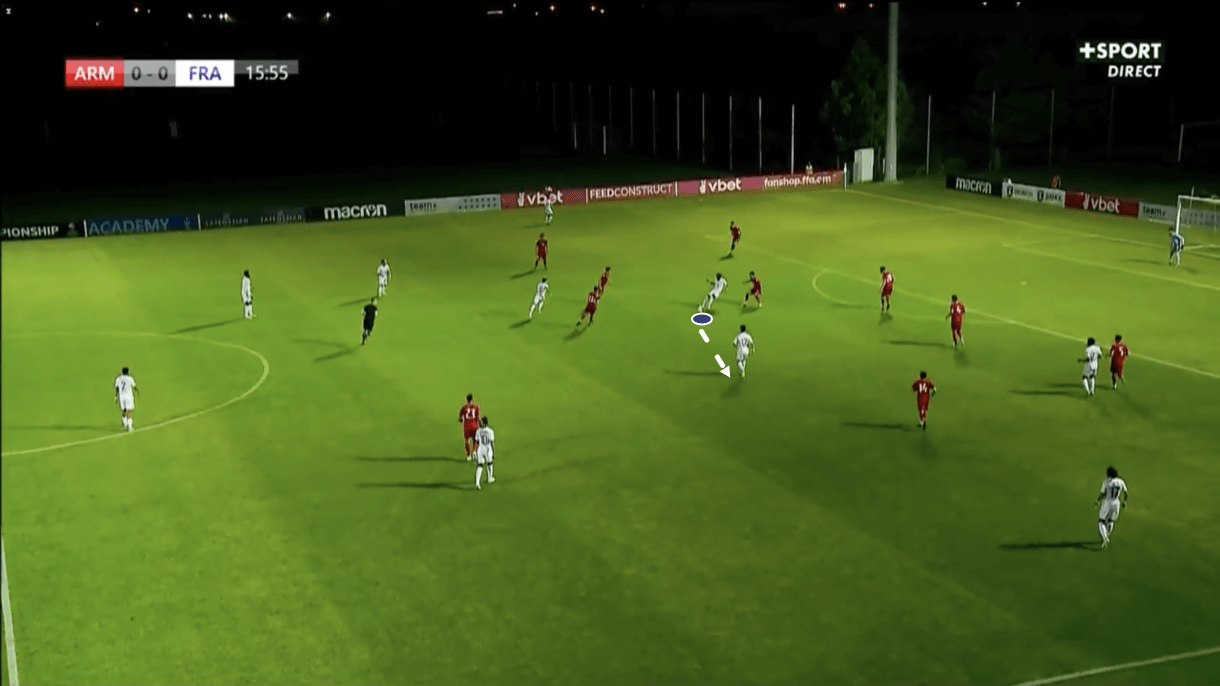
After receiving the pass, Kalimuendo needed just one touch to send it to another midfielder positioned on the opposite side of him to the midfielder from whom he’d received the ball, demonstrating how the striker’s movement created a nice triangle of France shirts in a dangerous area.
With the opposition’s right centre-back pulled out of position now, this created an opportunity for perhaps Kalimuendo to turn and target space behind that player too but first and foremost, the striker’s movement allowed his team to progress beyond the midfield line and get into a more threatening position. This is something we frequently see the PSG man offer his team, with the 20-year-old having demonstrated the ability to pull off this type of play as well at Lens.
So, if you need a striker who’s comfortable dropping off from the backline and linking up with midfielders as we see in figures 10-11, Kalimuendo is a good option to have.
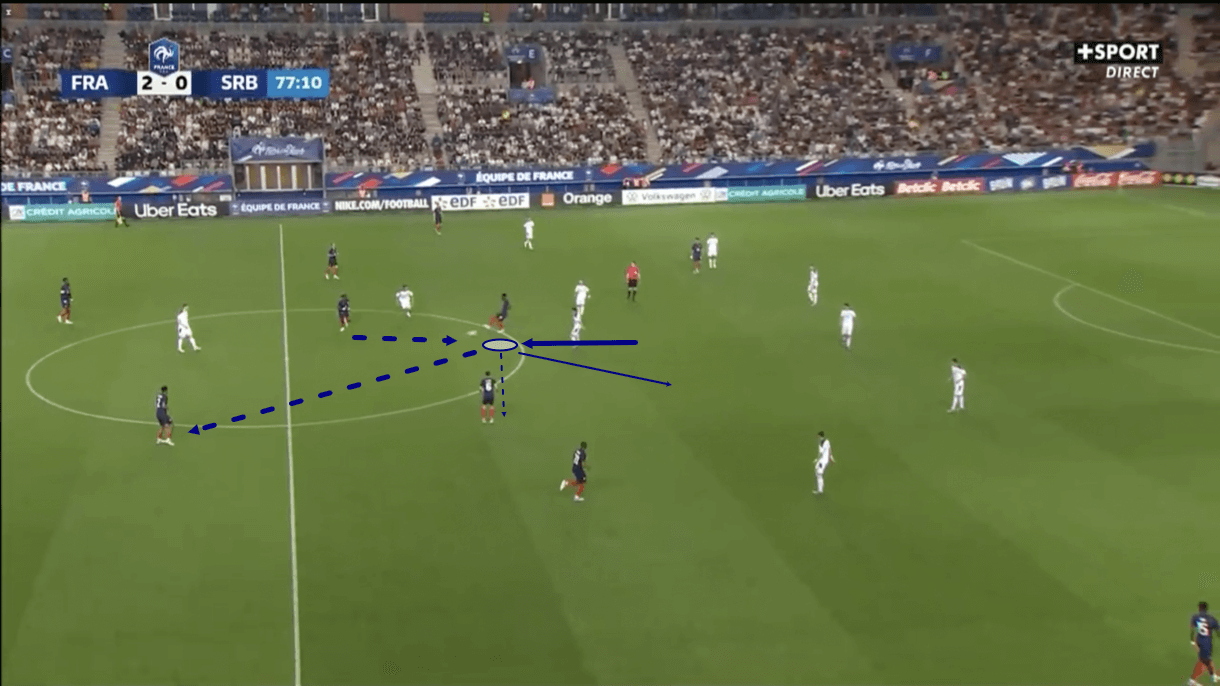
While the striker’s technical ability in this regard is great, he can improve mentally with his spatial awareness. For example, in figure 12, the forward has just dropped off from the backline before this image to receive from his right, similar to what we saw in figure 10.
Again, similarly, the striker plays the ball to a teammate on his left with one touch to quickly keep the play moving. However, this saw him ignoring an even more advanced option on his left, along with the option of taking another touch or even possibly receiving on the half-turn and carrying forward himself, as he wasn’t followed as closely as he perhaps believed by the opposition midfielder behind him. So, better scanning is possible and can help Kalimuendo to make better decisions.
When players are tight to his back, however, Kalimuendo demonstrates good use of his body to hold players off. While his 175cm height isn’t massive, he’s fairly well built and well able to use his size and strength to his advantage. This, along with the impressive technical ability we mentioned earlier, makes hold-up play an important key area of his game.
Areas of improvement
Along with the aforementioned weaknesses/areas of improvement (scanning, creative passing and to an extent — shot selection), Kalimuendo has two more major areas of improvement. These are 1. Aerial ability and 2. Defensive work rate.
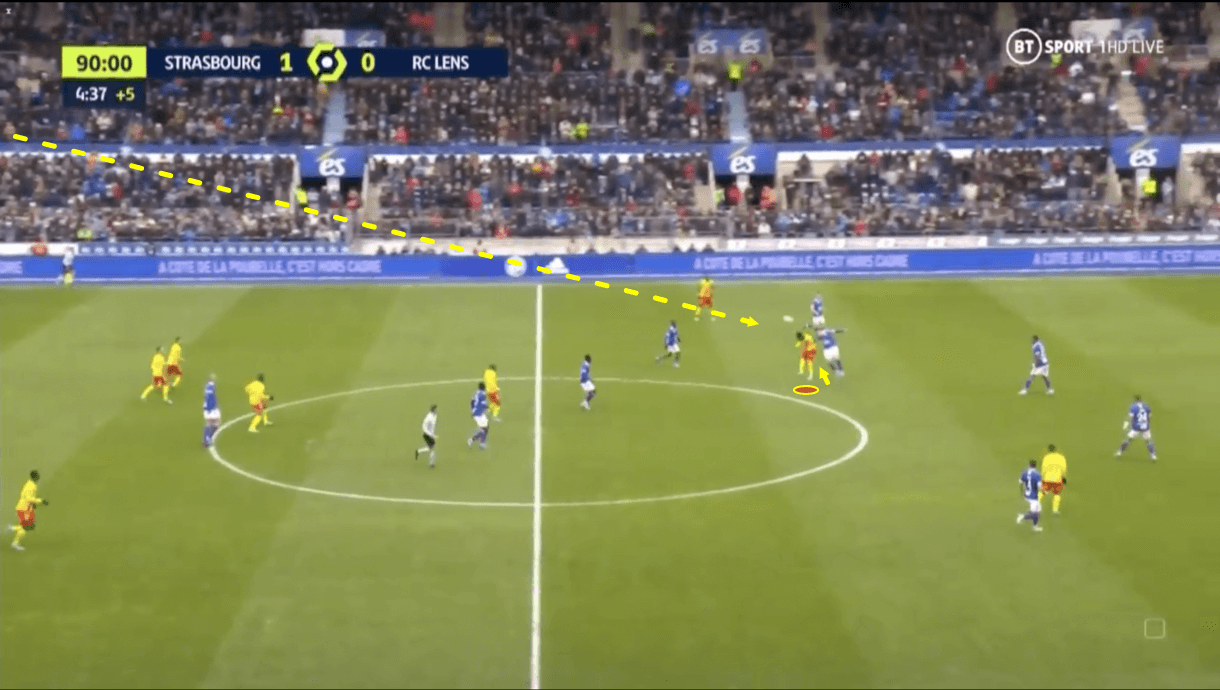
Aerially, the PSG man is bad. He has a poor technique when entering aerial duels both with his jumping height and with how he attempts to win the battle against the defender. We can see an example of this technique by observing his jump in figure 13.
The attacker doesn’t get very high off the ground, often jumping off just one foot rather than both feet which naturally generates less power but that’s not the worst thing in the world, either. Worse in this example is how he ducks his head in almost a bowing motion; this is a really common sight in Kalimuendo’s aerial duels and doesn’t help him to win the battle at all. It reduces his height and makes it easy for the opposition player to rise over him, which we can see in figure 13. So, Kalimuendo’s technical ability in the air, as well as physical ability, can do with some improvement.
Defensively, Kalimuendo simply doesn’t offer much to his side. He’s not very active in pressing with intensity nor does he track back much when required to help out at the other end. When he does engage — perhaps when there’s a loose pass near/in his zone, for instance — his defensive ability isn’t too bad. He’s capable of getting his body between the man and the ball and regaining possession for his side. However, the work rate needs to improve to function well off the ball, otherwise, he’ll be extra weight his team needs to carry.
At times, having Kalimuendo cheat and remain at the business end of the pitch could be a good option but still, you’d ideally like him to at least offer more than he does currently.
Conclusion
To conclude this tactical analysis and scout report, it’s clear why Kalimuendo is such a highly-rated talent at present, even among the heavily stacked market of Ligue 1 centre-forwards. The attacker demonstrates effective movement and a great variety of movement in attack to offer his team’s playmakers options, he’s technically a lethal shooter and he offers his team plenty of ability in link-up play.
However, Kalimuendo is far from the finished product and he can vastly improve aerially, defensively, creatively, with spatial awareness and with shot selection. Still, he’s an exciting talent who, we have no doubt, plenty of top-quality coaches would love to work with and develop in these areas, while still honing those in which he currently excels.





Comments